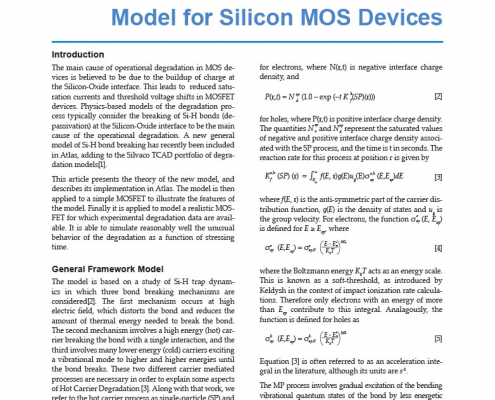
Generally Applicable Degradation Model for Silicon MOS Devices
The main cause of operational degradation in MOS devices is believed to be due to the buildup of charge at the Silicon-Oxide interface. This leads to reduced saturation currents and threshold voltage shifts in MOSFET devices. Physics-based models of the degradation process typically consider the breaking of Si-H bonds (depassivation) at the Silicon-Oxide interface to be the main cause of the operational degradation. A new general model of Si-H bond breaking has recently been included in Atlas, adding to the Silvaco TCAD portfolio of degradation models[1].
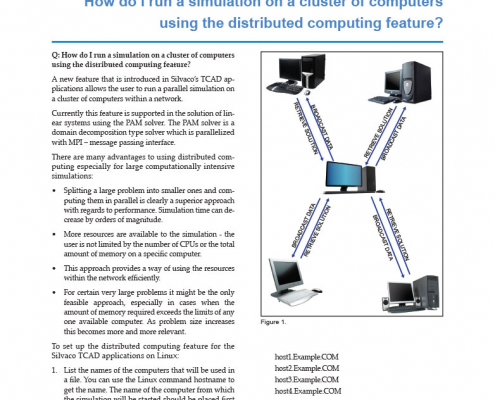
Hints, Tips, and Solutions – Simulation on a Cluster of Computers Using the Distributed Computing Feature
A new feature that is introduced in Silvaco’s TCAD applications allows the user to run a parallel simulation on a cluster of computers within a network.
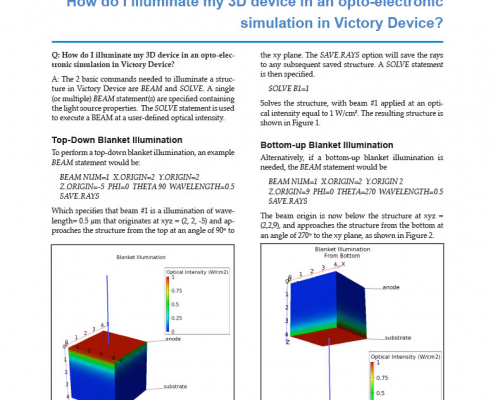
Hints, Tips and Solutions – Illuminate a 3D device in a Victory Device Opto-electronic Simulation
A: The 2 basic commands needed to illuminate a structure in Victory Device are BEAM and SOLVE. A single (or multiple) BEAM statement(s) are specified containing the light source properties. The SOLVE statement is used to execute a BEAM at a user-defined optical intensity.
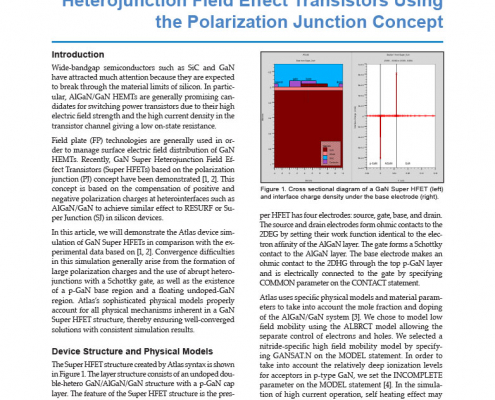
Atlas Simulation of GaN-Based Super Heterojunction Field Effect Transistors Using the Polarization Junction Concept
Wide-bandgap semiconductors such as SiC and GaN have attracted much attention because they are expected to break through the material limits of silicon. In particular, AlGaN/GaN HEMTs are generally promising candidates for switching power transistors due to their high electric field strength and the high current density in the transistor channel giving a low on-state resistance.
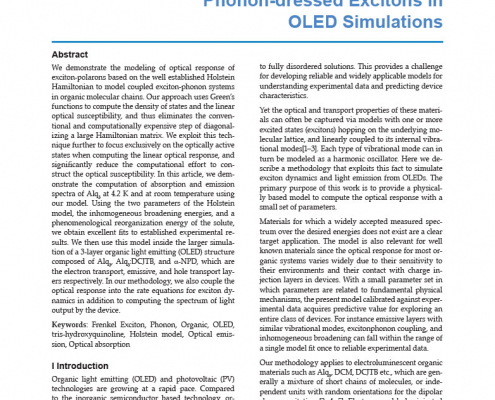
Modeling the Optical Response of Phonon-dressed Excitons in OLED Simulations
We demonstrate the modeling of optical response of exciton-polarons based on the well established Holstein Hamiltonian to model coupled exciton-phonon systems in organic molecular chains. Our approach uses Green’s functions to compute the density of states and the linear optical susceptibility, and thus eliminates the conventional and computationally expensive step of diagonalizing a large Hamiltonian matrix. We exploit this technique further to focus exclusively on the optically active states when computing the linear optical response, and significantly reduce the computational effort to construct the optical susceptibility. In this article, we demonstrate the computation of absorption and emission spectra of Alq3 at 4.2 K and at room temperature using our model. Using the two parameters of the Holstein model, the inhomogeneous broadening energies, and a phenomenological reorganization energy of the solute, we obtain excellent fits to established experimental results. We then use this model inside the larger simulation of a 3-layer organic light emitting (OLED) structure composed of Alq3, Alq3:DCJTB, and α-NPD, which are the electron transport, emissive, and hole transport layers respectively. In our methodology, we also couple the optical response into the rate equations for exciton dynamics in addition to computing the spectrum of light output by the device.
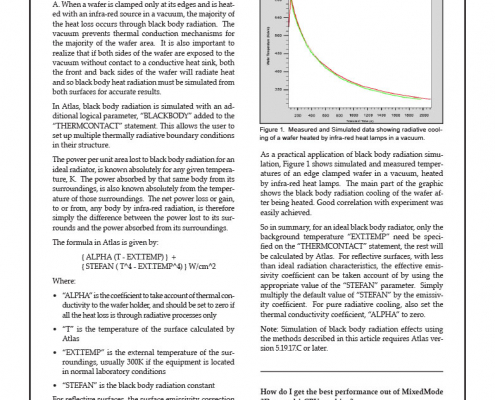
Hints, Tips, and Solutions – Simulate Rapid Thermal Annealing Temperature Transients in Vacuum
When a wafer is clamped only at its edges and is heated with an infra-red source in a vacuum, the majority of the heat loss occurs through black body radiation. The vacuum prevents thermal conduction mechanisms for the majority of the wafer area. It is also important to realize that if both sides of the wafer are exposed to the vacuum without contact to a conductive heat sink, both the front and back sides of the wafer will radiate heat and so black body heat radiation must be simulated from both surfaces for accurate results.
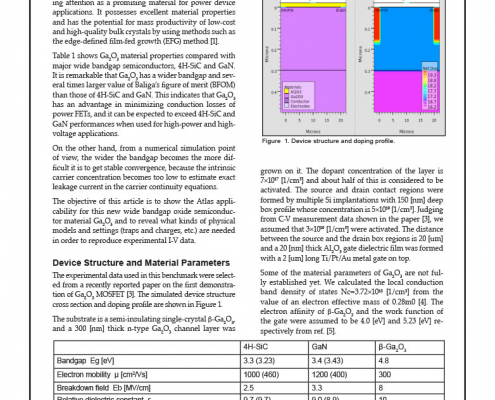
Atlas Simulation of a Wide Bandgap Gallium Oxide (Ga2O3) MOSFET
Single-crystal gallium oxide (Ga2O3) has attracted increasing attention as a promising material for power device applications. It possesses excellent material properties and has the potential for mass productivity of low-cost and high-quality bulk crystals by using methods such as the edge-defined film-fed growth (EFG) method [1].
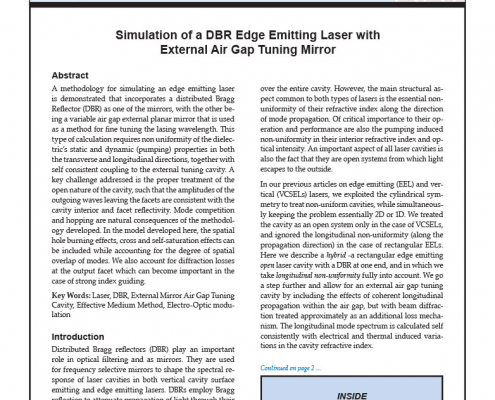
Simulation of a DBR Edge Emitting Laser with External Air Gap Tuning Mirror
A methodology for simulating an edge emitting laser is demonstrated that incorporates a distributed Bragg Reflector (DBR) as one of the mirrors, with the other being a variable air gap external planar mirror that is used as a method for fine tuning the lasing wavelength. This type of calculation requires non uniformity of the dielectric’s static and dynamic (pumping) properties in both the transverse and longitudinal directions, together with self consistent coupling to the external tuning cavity. A key challenge addressed is the proper treatment of the open nature of the cavity, such that the amplitudes of the outgoing waves leaving the facets are consistent with the cavity interior and facet reflectivity. Mode competition and hopping are natural consequences of the methodology developed. In the model developed here, the spatial hole burning effects, cross and self-saturation effects can be included while accounting for the degree of spatial overlap of modes. We also account for diffraction losses at the output facet which can become important in the case of strong index guiding.
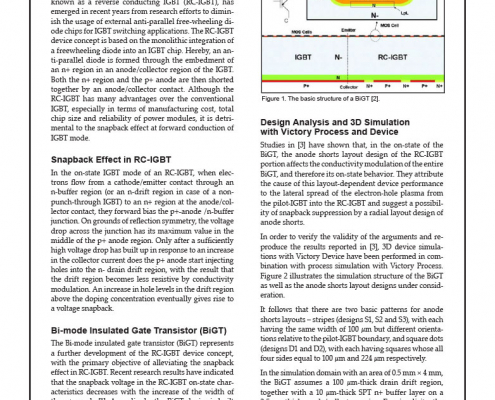
Anode Shorts Layout Dependence of Bi-mode IGBT (BiGT) On-state Characteristics
A new class of high-voltage semiconductor devices, known as a reverse conducting IGBT (RC-IGBT), has emerged in recent years from research efforts to diminish the usage of external anti-parallel free-wheeling diode chips for IGBT switching applications. The RC-IGBT device concept is based on the monolithic integration of a freewheeling diode into an IGBT chip. Hereby, an anti-parallel diode is formed through the embedment of an n+ region in an anode/collector region of the IGBT. Both the n+ region and the p+ anode are then shorted together by an anode/collector contact. Although the RC-IGBT has many advantages over the conventional IGBT, especially in terms of manufacturing cost, total chip size and reliability of power modules, it is detrimental to the snapback effect at forward conduction of IGBT mode.
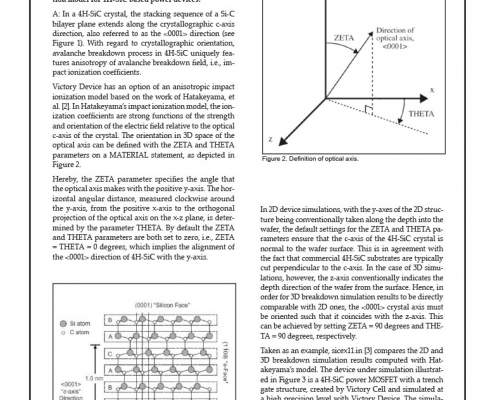
Hints, Tips and Solutions – Compare the Results of Breakdown Simulations with Hatakeyama’s Impact Ionization Model for 4H-SiC Based Power Devices
In a 4H-SiC crystal, the stacking sequence of a Si-C bilayer plane extends along the crystallographic c-axis direction, also referred to as the <0001> direction (see Figure 1). With regard to crystallographic orientation, avalanche breakdown process in 4H-SiC uniquely features anisotropy of avalanche breakdown field, i.e., impact ionization coefficients.
